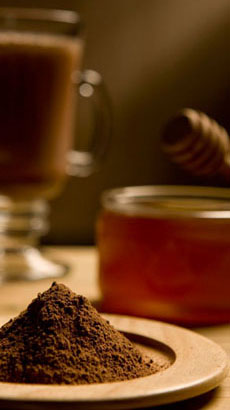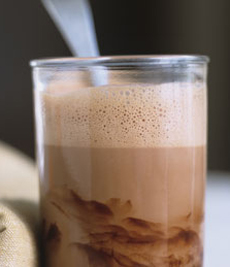Chocolate Glossary: A Glossary Of The Different Chocolate TypesPage 4: Health Benefits Of Cocoa This is Page 4 of an 6-page article. Click on the red links below to visit other pages. This glossary is protected by copyright and cannot be reproduced in whole or part. You are welcome to link to it.
|
 Cocoa powder is high in antioxidants. Photo courtesy Epullen.com. |
|
|
Chocolate And Antioxidants
|
 We know chocolate is high in antioxidants; we just don’t know how much the human body needs for efficacy. Or, how to counterbalance the calories if, say, you need to eat 3.5 ounces of chocolate a day. Photo by Melody Lan | THE NIBBLE. |
|
|
Chocolate And Nutrition Much of the research now being done on cacao (chocolate) is done on high-quality cocoa powder. It may be that our future “health drink” will be a flavonoid-enhanced cocoa powder with an artificial sweetener and fat-free milk, so as not to pack on the calories. But today, cocoa is no health drink. Certainly, along with the antioxidants, what you’re getting with your hot cocoa or hot chocolate is some nutrition, especially if your drink is made with milk. Inescapably, though, you’re imbibing calories, sugar and fat (although cocoa butter is a heart-healthy fat), and often, significant sodium. Many manufacturers do not list nutrition information for their drinking chocolates and hot cocoas. This is doubtless to their benefit, as few Americans would rejoice in discovering what a steaming mug of hot chocolate or hot cocoa can add to their daily intake. While L.A. Burdick Hot Chocolate, a NIBBLE Top Pick Of The Week, weighed in at 600 calories a cup (it’s virtually melted chocolate bars—and divine), there are “bargains” to be had. Nestlé Hot Cocoa Mix (Rich Chocolate) contains 80 calories, 3 grams of fat, 12 grams of sugar and 170 mg of sodium per serving when made with water. It’s hardly a rich, chocolatey experience. Lake Champlain’s New World Drinking Chocolate, a drinking chocolate made with milk, contains 145 calories, 11.5 grams of fat, 8 grams of sugar, and roughly 38 mg of sodium per serving—before you add the milk used to concoct the beverage. Add 90 calories for 8 ounces of fat-free milk or 150 calories for whole milk, and that’s 235 to 295 calories for the cup—as much as a serving of superpremium ice cream. |
 The milk in hot chocolate provides nutrition, but that doesn’t make it a “health drink.” Photo courtesy Recchiuti Confections. |
|
|
Got Additives? On the other side of the health coin, that particular Lake Champlain preparation contains one ingredient—dark chocolate—while the Nestlé mix contains such delightful additives as corn syrup solids, partially hydrogenated and hydrogenated oils, sodium silicoaluminate, cellulose gum, dipotassium phosphate, sodium caseinate and artificial flavors, along with the basic sugar, cocoa processed with alkali and nonfat milk. So calories and fat grams aren’t the only story here. With supermarket brands, you’ll find additives; the “premium” brands generally don’t have them. Check the labels. Work It Out Continue To Page 4b: Hot Chocolate As An Aphrodisiac |
||
Last Updated May 2018
© Copyright 2005-2025 Lifestyle Direct, Inc. All rights reserved. All images are copyrighted to their respective owners.